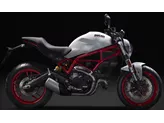Kawasaki Z650 2017 vs. Kawasaki Z900 2019

Kawasaki Z650 2017

Kawasaki Z900 2019
Overview - Kawasaki Z650 2017 vs Kawasaki Z900 2019
The Kawasaki Z650 2017 and the Kawasaki Z900 2019 are both naked bikes from Kawasaki, but they have several differences in terms of technical specifications and strengths.
Starting with the engine and drive train, the Kawasaki Z650 2017 is equipped with an in-line, liquid-cooled engine with a displacement of 649cc. It produces 68.2 horsepower and 65.7 Nm of torque. On the other hand, the Kawasaki Z900 2019 also has an in-line, liquid-cooled engine but with a larger displacement of 948cc. It delivers a higher power output of 125.4 horsepower and 98.6 Nm of torque. This means that the Z900 has a more powerful engine compared to the Z650.
In terms of suspension, both bikes have a swing arm rear suspension with a monoshock absorber. However, the Z650 has a telescopic fork front suspension, while the Z900 is equipped with an upside-down telescopic fork front suspension. The Z900's upside-down fork provides better handling and stability, making it more suitable for aggressive riding.

Kawasaki Z650 2017
The chassis of both bikes is made of steel, but the Z650 has a tubular frame while the Z900 has a double cradle frame. The double cradle frame of the Z900 offers better rigidity and stability, contributing to its light and natural handling.
When it comes to braking, both bikes have double disk brakes at the front with a diameter of 300mm. However, the Z900 has four-piston calipers at the front, providing better braking performance compared to the Z650's double-piston calipers.
Both bikes are equipped with ABS as an advanced rider assistance system, ensuring safer braking in emergency situations.
In terms of dimensions and weights, the Z650 has a wheelbase of 1410mm, while the Z900 has a slightly longer wheelbase of 1450mm. The seat height of the Z650 is 790mm, while the Z900 has a slightly higher seat height of 795mm. The Z900 also has a wider rear tire with a width of 180mm, compared to the Z650's 160mm rear tire. The Z900 is slightly heavier with a kerb weight of 210kg, compared to the Z650's 187.1kg.

Kawasaki Z900 2019
Now, let's discuss the strengths and weaknesses of each bike. The Z650 has an even power delivery, a sporty chassis, and compact dimensions. It also features a negative display, which can be easier to read in certain lighting conditions. However, it may be a little too small for taller riders.
On the other hand, the Z900 offers light and natural handling with high stability. Its engine provides a silky smooth power delivery with full pull from mid revs. The chassis of the Z900 offers great feedback and transparency, enhancing the riding experience. The sitting position of the Z900 is comfortable and provides a feel-good factor. Additionally, the Z900 is priced fairly, making it an attractive option for riders. However, it has a TFT display mounted too low, which may require the rider to take their eyes off the road, and the rear view mirrors offer modest visibility.
In conclusion, the Kawasaki Z650 2017 and the Kawasaki Z900 2019 are both impressive naked bikes from Kawasaki, but the Z900 offers more power, better handling, and additional features. However, it is important for potential buyers to consider their own preferences and requirements before making a decision.
Technical Specifications Kawasaki Z650 2017 compared to Kawasaki Z900 2019
Pros and Cons in comparison
Pros and Cons in comparison
Kawasaki Z650 2017

The Kawasaki Z 650 is the tip of the middle class for small male and female riders. On its compact dimensions, you probably won't feel comfortable as a giant. Heart-warming feelings, however, come from the engine, which delights with a very smooth pull. On the chassis side, a Kawasaki-typical tight set-up was chosen, which finds a great compromise in everyday use. The negative display is very easy to read and is reminiscent of its predecessor, the ER-6n - very nice!
Kawasaki Z900 2019

Fortunately, the new Kawasaki Z900 has lost none of its character through the use of electronics. It is and remains a playful mid-range naked bike, which at the same time masters the brisk pace on the country road magnificently. The riding pleasure and suitability for everyday use are high, the now installed riding aids offer a plus in safety. Your opponents will have a really hard time from now on.
Price Comparison Avarage Market Price Kawasaki Z650 vs Kawasaki Z900
There are a few key differences between a Kawasaki Z650 2017 and a Kawasaki Z900 2019. In terms of price, the actual average price of a Kawasaki Z900 2019 is about 55% higher. A Kawasaki Z650 2017 experiences a loss of 350 GBP in one year of ownership. This is offset by a loss of 230 GBP for a Kawasaki Z900 2019. Compared to Kawasaki Z900 2019 there are less Kawasaki Z650 2017 bikes available on the 1000PS.de Marketplace, specifically 11 compared to 40. It takes less time to sell a Kawasaki Z650 with 76 days compared to 116 days for a Kawasaki Z900. Since model year 2017 1000PS.de editors have written 31 reviews for the Kawasaki Z650 and 46 reviews for the Kawasaki Z900 since model year 2017. The first review for the Kawasaki Z650 was published on 08/11/2016 and now has more than 25,000 views. This compares to more than 93,200 views for the first review on Kawasaki Z900 published on 11/11/2016.





















